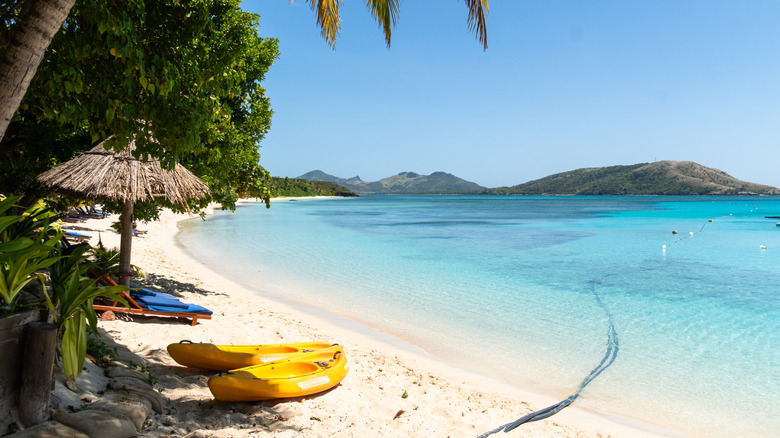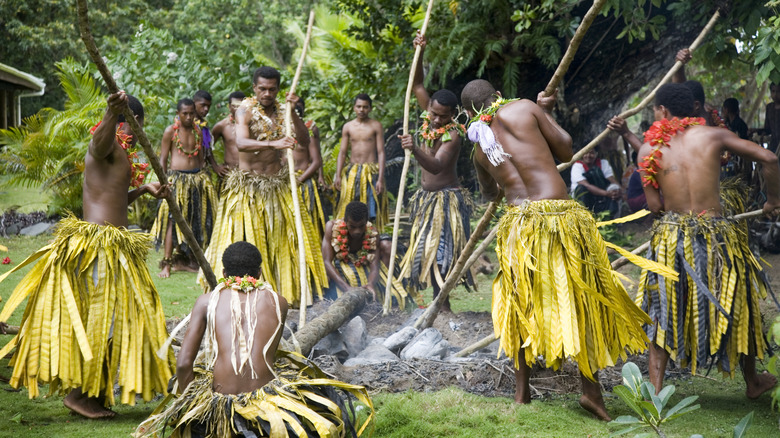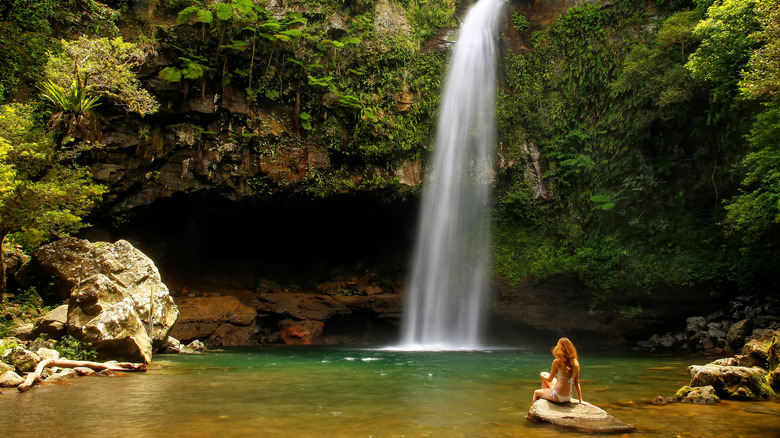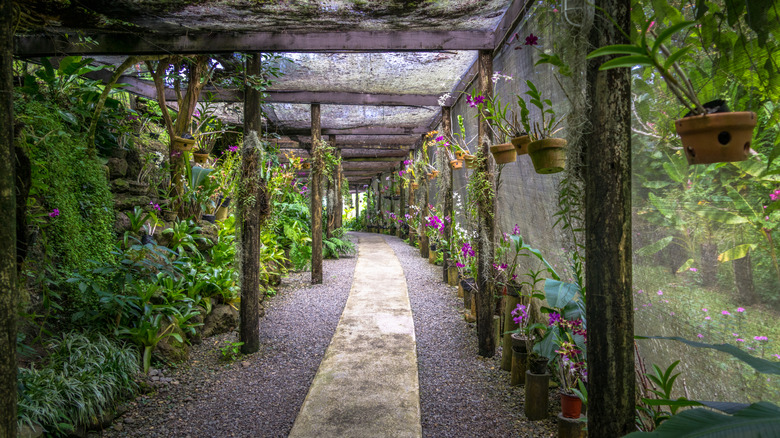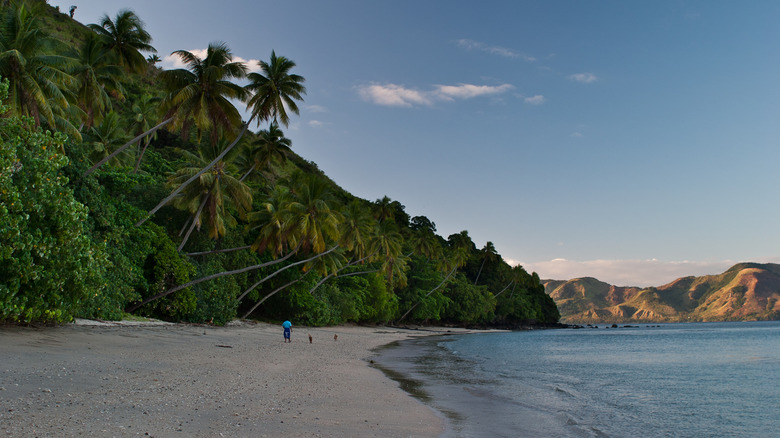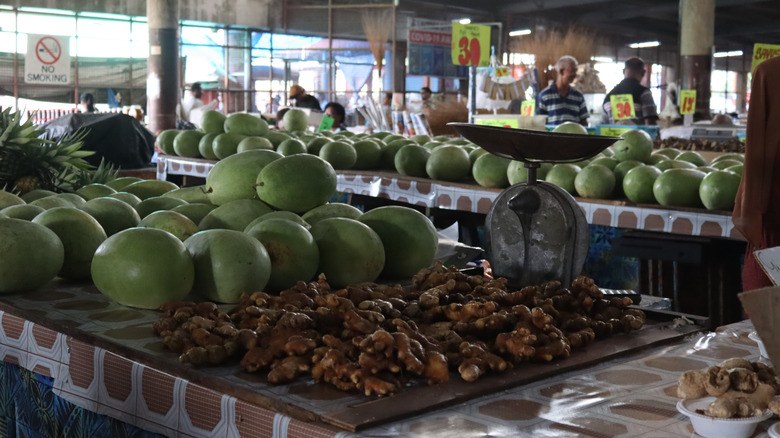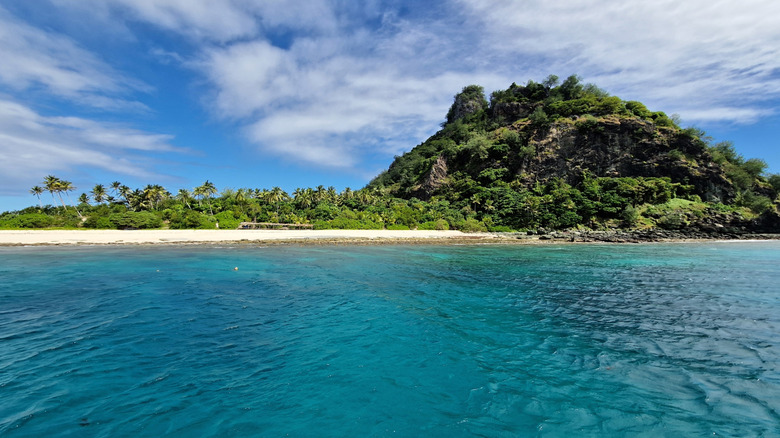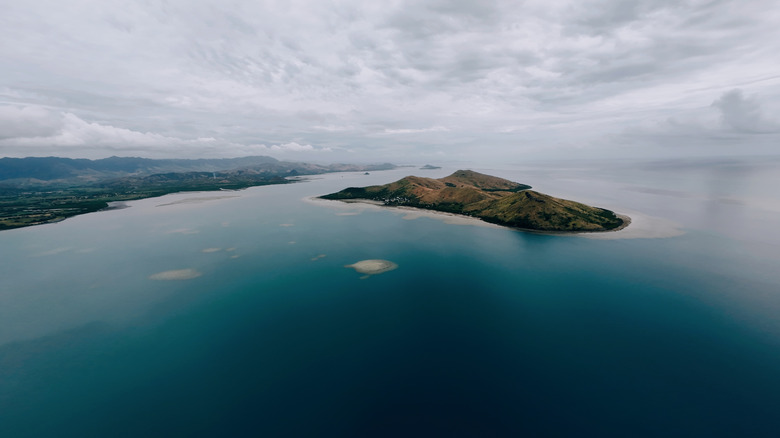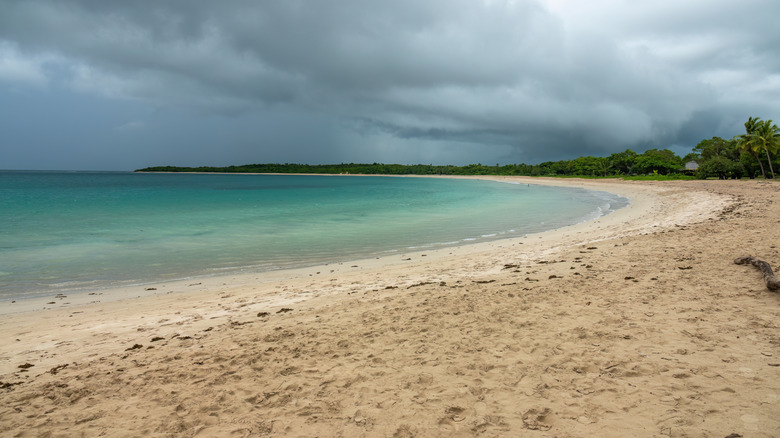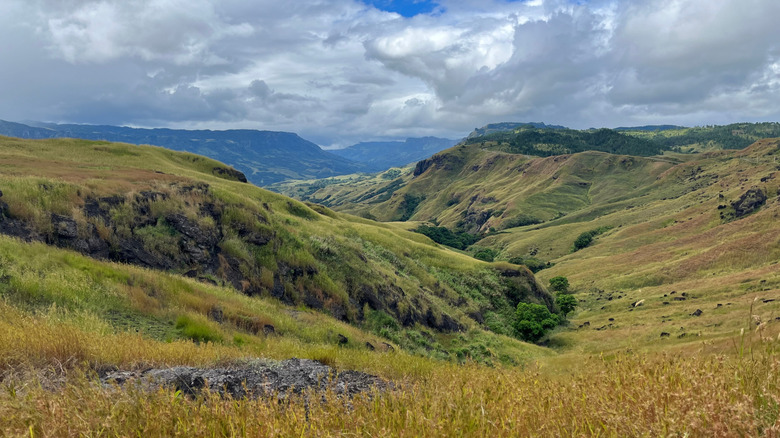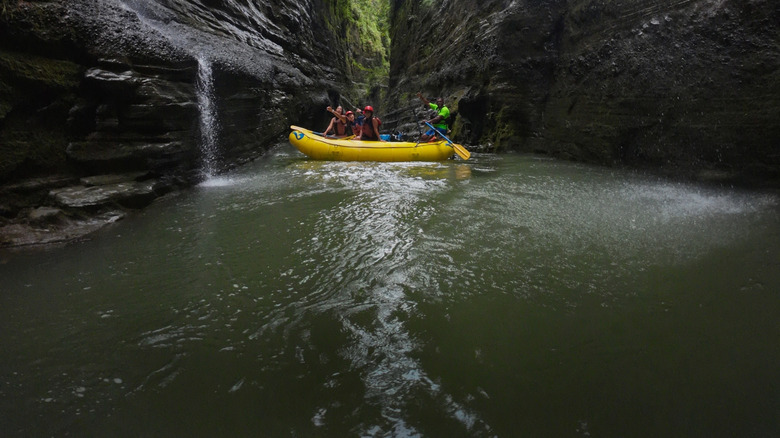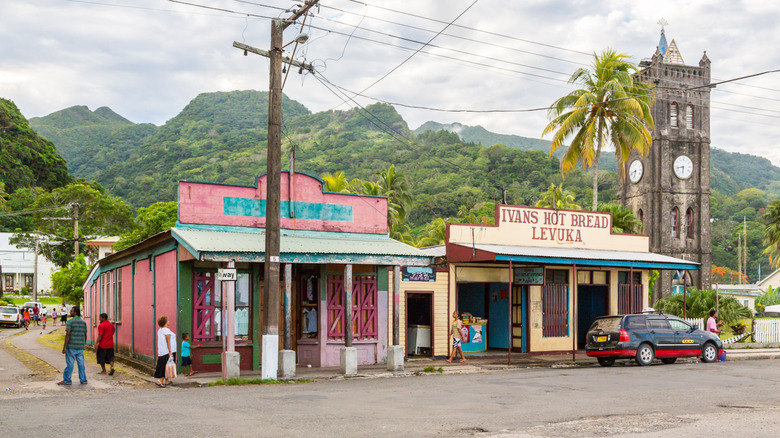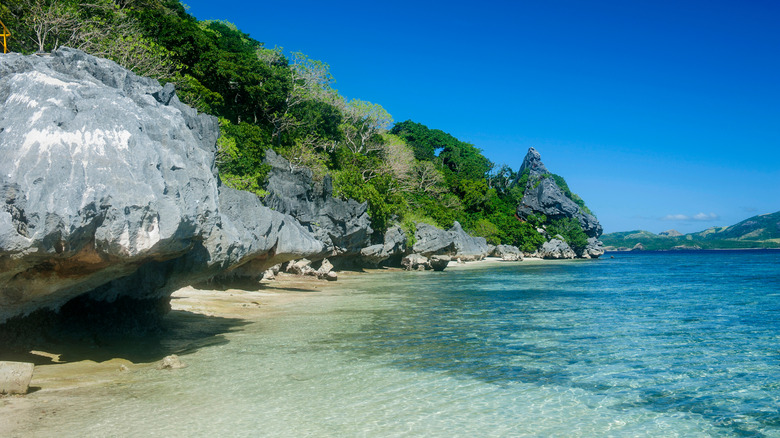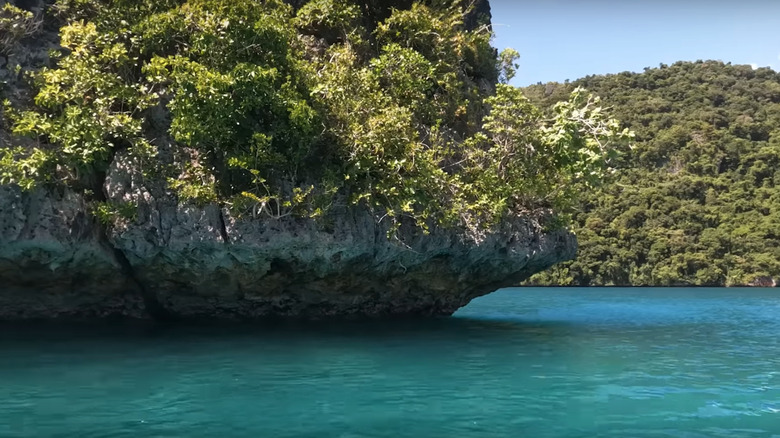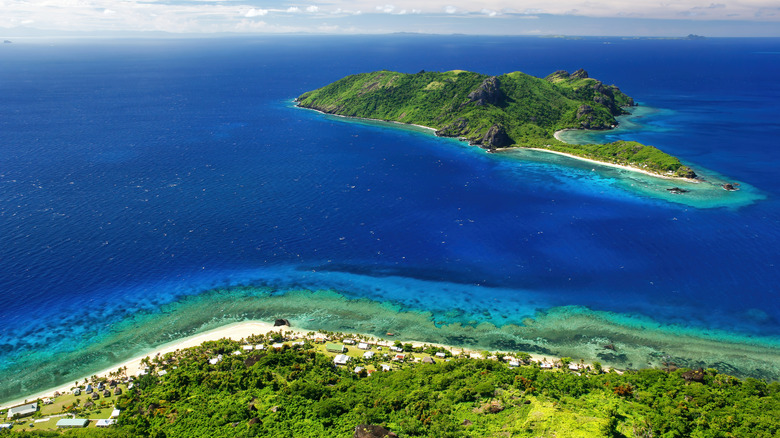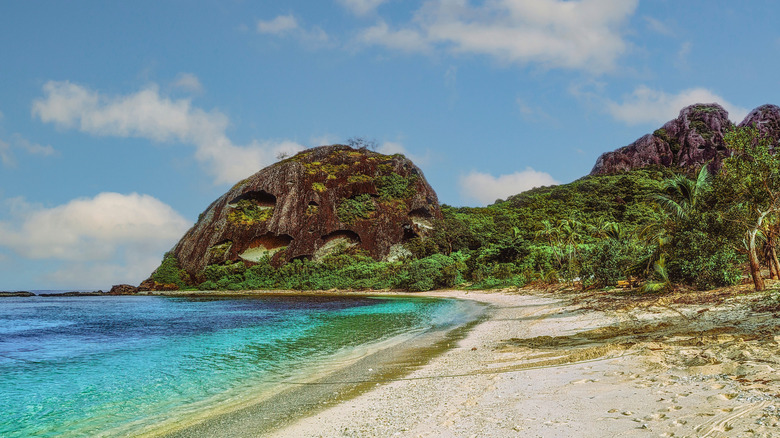Best Remote Destinations In Fiji For A Crowd-Free Vacation
A nation in the South Pacific, Fiji is what many people picture when they imagine paradise. It's a realm of lush rainforests, cloud-cloaked mountains and valleys, and long, sweeping soft-sand beaches. And that's not even mentioning the gorgeous sea, clear, warm waters that teem with healthy coral and pulse with marine life. There are hundreds of islands scattered across Fiji, but only about one-third are populated. Tourism is a well-established industry, with more than 900,000 visitors coming to the country in 2023 (similar to the nation's population of 925,000).
Many travelers will visit to stay in the plush resorts, or on some of the top-rated islands in Fiji. In the case of the latter option, variety ensures that there is always a Fiji island for your travel style. However, some parts of the country seem to soak up much of the tourism business. These include the resorts up and down the coast near the airport at Nadi, the main city of Suva, and the highly developed tourism enclave of Denarau Island. But Fiji offers so much more than these tried-and-tested destinations. We pored over blogs to find some of the best remote destinations where you won't be battling crowds, but will still have a good time.
Beqa
This small island shaped a little like a puffer fish, sits just south of Viti Levu, Fiji's main isle. Compared to its northern neighbor, it really is tiny, and there isn't a lot of development on Beqa. Visitors can stay at a few plush resorts and wander along tranquil, sumptuous beaches. But a couple of reasons make Beqa (which is actually pronounced as "Benga") a destination that may be off-the-beaten-track, but should definitely be visited. The diving around Beqa Lagoon, right by the Beqa Lagoon Resort, is phenomenal. While the island is the top part of a sunken, extinct volcano, the lagoon is the section that was the crater.
Divers will find walls blanketed in coral, and varied sea life that includes clownfish, longnose, and turtles. In some parts, manta rays, tiger sharks, and whales also make an appearance. Back on land, a huge attraction is the island's fire-walking history, which dates back five centuries. A local legend is attached to the art of fire-walking here, one to do with spirits. According to lore, only descendants of the original fire walker from hundreds of years ago possess the power to walk over hot stones unscathed. Today, fire-walking ceremonies take place on the island and involve hardy participants trampling over fire-heated stones.
Bouma National Heritage Park
North of Viti Levu, which translates to "great Fiji," is the island of Taveuni. Known locally as the "Garden Isle," Taveuni is truly a place of resplendent nature that we've had the good fortune of visiting. This is a realm of lush rainforests, thundering waterfalls, and the striking Somosomo Strait, a bucket-list diving region. Intrepid hikers can clamber up Des Voeux Peak in search of the rare Tagimoucia flower. One spot that is worth seeking out is Bouma National Heritage Park. It covers one-third of the island and is a beautiful slash of unspoiled outdoors. There are hiking trails all around it, and more than 100 different species of birds that call it home.
For some visitors, the park's highlight is the majestic Tavoro Waterfalls. There are three in total, and each falls into a pool ideal for a cooling dip. Look carefully around the cascades and you might see bright purple crabs scuttling around the rocks nearby. Hikers can take walks in the rainforest, or try the renowned Lavena Coastal Walk. It passes through villages, along the coast, and on white- and black-sand beaches.
Garden of the Sleeping Giant
To get to this botanical garden from the international airport takes about 15 minutes by car. And yet, once you arrive at this calm location, you might feel as though you have traveled, physically and mentally, so much further. The garden is thousands of miles away from Hollywood, but it owes its existence to an American TV star. Raymond Burr, the actor who most famously played Perry Mason and Ironside in those eponymously named television shows, opened this place in 1977 to show off orchids.
The flowers on display were primarily his private orchid collection. Now, the site spreads over 30 hectares and boasts some impressive statistics. There are more than 2,000 different orchids in the garden, while many other flowers and trees flourish and bloom on site. Travelers can enjoy the surroundings via a walk that leads through the garden, taking in endemic trees and tranquil lily ponds. This is a place of exquisite natural beauty and exceptional calm.
Kadavu
Spend time on this island in the nation's south, and you'll see many things. Among them are wild, dense jungles where vines creep up the trees, windswept coastal headlands that push out toward the sea, and world-class beaches, with very few people in sight. The fourth-largest island in Fiji is a haven of wilderness and an off-the-beaten-path gem that offers a relaxing vacation and isn't overrun with tourists. What is in high concentration, however, is coral and marine life. The Great Astrolabe Reef, a behemoth among global barrier reefs, sits just south of Kadavu and has more than 50 dive sites. For fans of aquatic exploration, it is a joy to see, filled with legions of coral, and creatures like manta rays.
Travelers can also kayak, paddle board, go deep-sea fishing, or just lounge in the warm seas. On land, the attractions are equally alluring. Hiking is a fine option for seeing the isle's interior. The route to Kavala Bay waterfall, for instance, cuts through deep forests, and skirts small villages where visitors can get a sense of traditional Fijian life. On Kadavu's north, the Vatalutu Trail takes about three hours to complete and terminates on a quiet, little-trafficked beach. During a hike, look out for the island's four endemic birds, with the crimson flash or the yellow-headed whistling dove among them. Getting to Kadavu is a breeze, with a flight from Nadi taking less than one hour.
Lautoka
The drive from Nadi's international airport to Lautoka, the second-largest city in Fiji, is only about 30 minutes. But Lautoka remains surprisingly non-touristy. Sometimes nicknamed "Sugar City," due to the surrounding tracts of sugar cane, the town sits right by Mount Koroyanitu. The sugar industry can trace its origins to 1899 when the Colonial Sugar Refining Company aired plans to construct a wharf in Lautoka. A mill opened in 1903, and production and exports soon ramped up. The factory continues to make sugar, though the city also has timber, garment, and fishing industries among its roster.
Lautoka also has some fine beaches, like Saweni Beach, thanks to its location on a part of the island known as the Suncoast. Lautoka looms large in local culture, as it is believed to be where Fiji's first dwellers landed on Viti Levu. The city's name—"Lau Toka" means bullseye or spear hit— comes from a legend where two sparring chiefs got into a duel with spears, with the victor killing the vanquished with a fatal blow through the chest. Travelers will find a lively scene at Lautoka Market, where residents shop for their groceries, and streets with an easygoing ambiance.
Monuriki
While Robinson Crusoe was a fictional character, you can get a sense of how he felt with his journey to Monuriki Island. Also known as Modriki Island, this is where the Tom Hanks movie "Cast Away" was filmed, and it can be visited on a day trip. Episodes on the reality show "Survivor" were also shot there, further cementing the island's status as a place that is remote and removed from everyday society. The isle owes its genesis to volcanic forces, part of the Mamanuca Islands that together made up a giant volcano.
And yet, despite being so remote, it is home to natural riches, with the rare Fiji crested iguana found here, and the Hawksbill turtle regularly laying eggs in the sands. Since the island has no facilities, and takes a little effort to reach — visitors without their own boat need to sign up for a tour — the island is never busy. And once you're on it, the sense of feeling like a real castaway is tangible.
Nananu-i-Ra
If you're looking for a real escape, then this island off the north coast of Viti Levu might be just the spot. With a jagged, undulating coastline, the isle is small, and despite its proximity to Fiji's largest island, it feels quite distant from everyday life. This is because there aren't any roads on the island, and no residents on the island, just a handful of unfussy places to stay and some plush vacation homes. There are verdant hills in the island's interior and plains that rise and fall once grazed by cattle.
The shore is populated with a clutch of finely curving sandy bays and tracts of dense mangroves. Nananu-i-Ra, whose name translates to "Daydream of the West" — in Fijian lore, spirits leave the island to enter the afterlife — is a great place for relaxing and just hanging out. One of the finest beaches in the whole of the country is found here, Oni Beach on the island's north coast. For travelers who like their outdoor experiences a little more thrilling, the waters around Nananu-i-Ra are excellent for kiteboarding and windsurfing, while coral reefs invite snorkeling excursions.
Natadola Beach
Even though it's less than an hour by car from Nadi, this fine beach manages to escape the massed hordes and retain an air of relative quiet. At the southern end of the beach, travelers will find the InterContinental Fiji Golf Resort & Spa, but apart from a sprinkling of other places to stay nearby, there isn't a whole lot of development on this beach. That is a bonus, and it means that visitors who make the journey here will be rewarded with a gently curling stretch of soft sand where you won't find legions of loungers and beach umbrellas.
This is also one of the best beaches in the country, one that will have you dreaming about a vacation in Fiji. Visit Natadola Beach, and what you will encounter are some enterprising locals offering souvenirs, massages, a tasty snack, maybe the chance to have a horse ride by the water, and little else. No facilities, no water sports centers, and no feeling that another natural gem has been spoiled by mass tourism.
Nausori Highlands
Many travelers find they are irresistibly pulled by Fiji's beaches. The chance to lay on sugary sand, or slide into silky seas is too good an opportunity to pass up. But the interior of the islands is equally alluring. It is in the rugged interior of Viti Levu that travelers will come across the Nausori Highlands, an area that is a dream for hikers. While the beaches are very much horizontal landscapes, the terrain in the highlands, as the name suggests, is more vertical. A couple of peaks dominate all views — Koronayitu in the north, and Koromba in the south.
The undulating topography in between promises hikers exciting, and challenging routes, treks that take in authentic local villages and rural Fijian life. The beaches are also visible in the distance from some walks, as are island views and even distant vistas of the Mamanuca and Yasawa archipelagos. The panoramas also change depending on the seasons, from green during the rainier months, to gold in the drier periods.
Navua River
More stunning scenery awaits on the Navua River, a waterway that winds through deep rainforest. Also located on Viti Levu, it's not only a pretty spot, but also a great medium for kayaking or rafting, depending on which part of the river you tackle. The Upper Navua River is the most challenging section. It courses through rainforests replete with waterfalls but also features several churning rapids. This is where rafting on a guided trip, like excursions offered by Rivers Fiji, takes place.
Adventurers will come across rainforests, many waterfalls, and even sections of towering canyons where the walls are black, a vestige of volcanic activity. The Middle Navua River is better suited to travelers in search of a leisurely paddle. Trips pass small villages with stops for lunch where life continues as it has for centuries.
Ovalau
This unspoiled island is a short flight from Viti Levu and is home to some rich history. The historic town of Levuka, a Unesco World Heritage site, is on Ovalau, and it was the first colonial capital of Fiji. Levuka is a low-rise city, and along its waterfront, visitors will find mango trees and coconut palms. The British chose it as their capital of Fiji in 1874 when King Cakobau handed control of the town over to the colonizers.
By then, Levuka had already established its importance as a center of commerce, and visitors will see the evidence of that from the stone sea wall from which many roads radiate, and the warehouses and storage facilities along Beach Street. Ovalau remains unspoiled by tourists, despite being so close to Viti Levu — it's about 10 minutes by flight from Suva, the largest city in Fiji and also the capital. One road circumnavigates Ovalau, and while the edges of the island are ringed by beaches, the interior is notable for its mountains.
Sawa-i-Lau caves
Sometimes, on your travels, you come across places that, even when you see them, you can't quite believe they are real. That could be because of the grandness of scale, the setting, or a combination of factors. Sawa-i-Lau caves are such a place, a destination where hypnotic turquoise pools are surrounded by sheer limestone cliffs. These bodies of water sit within a cave complex, with sea water filling parts of the cavern, turning them into swimming holes.
Movie fans might even have seen these pools without realizing — they were featured in the movie "Blue Lagoon" with Brooke Shields. While this is a place of immense, spellbinding natural beauty, it is also steeped in local lore. A hawk that once lived in the cave abducted a princess from a nearby village. To get revenge, a prince rode the winds to fly to the cave and kill the hawk. Some believe that those winds continue to this day, and buffet the caves from time to time.
Vanua Balavu
Shaped like a twisting worm trying to avoid capture, this island sits in the eastern part of Fiji and is quite remote. It's also quiet and promises visitors who make the effort to go there some amazing snorkeling and diving opportunities. Travelers can get to Vanua Balavu a couple of ways — via plane from Suva, or on a boat, a much more picturesque method of arrival. The island is part of Fiji's Lau archipelago and presents visitors with stacks of limestone rock, hidden bays, coves, and wildly blue seas.
In those waters, travelers can spot vibrant coral reefs visited by myriad types of fish, and reef sharks that leisurely roam the sea. There is no real tourist infrastructure on the island, and only small villages, so the best way to experience the island is via a boat. That way you can get around the nooks and crannies of the island's coastline and find a secret hideaway all for yourself.
Wayasewa
One thing you won't find on this island in the Yasawa archipelago is large resorts with endless buffet spreads or kitschy evening dance performances put on for guests. This isle is located northwest of Viti Levu, and has some small local resorts, simple homestays, and little villages that are so tiny, they might not even show up on a map. To put it more plainly, a trip to Wayasewa will give travelers a taste of true Fiji. There is a large mountain in the center of the island, perhaps not surprising since this is part of a volcanic chain.
Some paths show travelers the route to climb to the top of the peak, and from the summit, the views of Kuata Island, to the south, are mesmerizing. You'll also be able to enjoy striking sunsets from the top. Slip into the waters from one of the island's beaches, and you will be able to watch the comings and goings of clownfish, turtles, and reef sharks. And for the rest of the time, kick back, take in the tranquility, and remember that a vacation is all about having a break. Just be sure to carry cash — banks and ATMs are nowhere to be found.
Methodology
While Fiji is a bucket-list destination for many travelers, strewn in the South Pacific halfway across the world from the U.S., it still gets a sizable share of travelers. Of them, a good proportion tend to stay in the resorts near the international airport at Nadi, on the island of Viti Levu, or close by. That's not surprising, since the best resorts in Fiji are dotted around its islands.
But the nation, which has certain things you need to know before your vacation, has so much more to offer than that small slice of its land. To find the best remote destinations around Fiji — and there are many — we consulted blogs like Far & Away Adventures, Fiji Pocket Guide, and also the official Fiji tourism site. By pulling information from sources that had first-hand knowledge of the many islands and destinations of Fiji, we were able to put together a comprehensive list of remote destinations that will leave you with priceless memories of this South Pacific nation.
